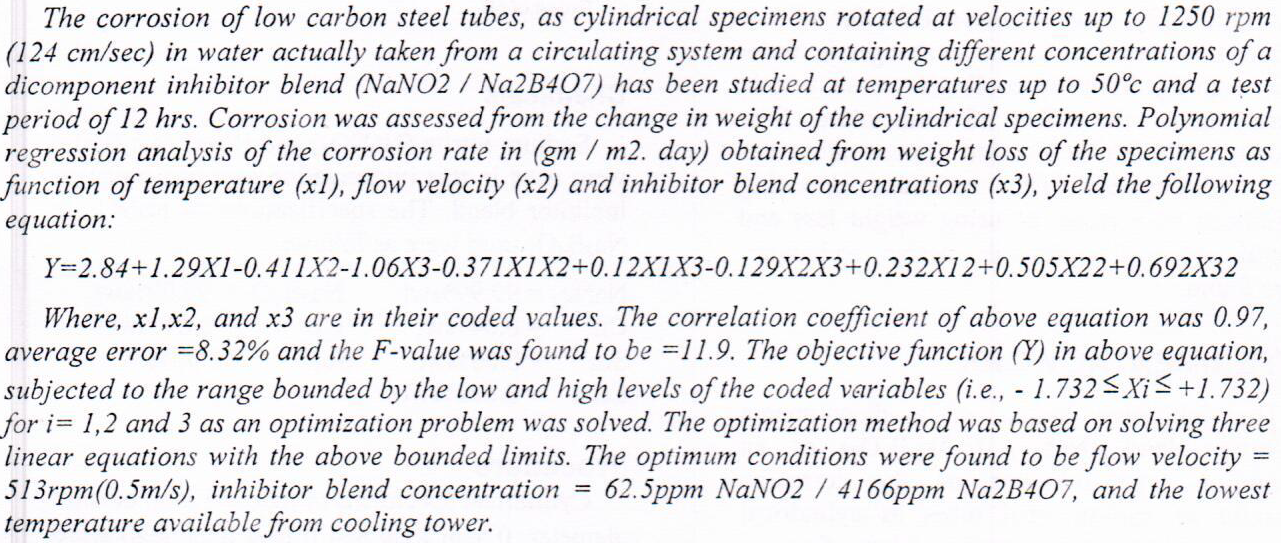
Abstract
Experimental work from Magnetic Abrasive Finishing (MAF) tests was carried out design parameters (amplitude, and number of cycle which are formed the shape of electromagnetic pole), and technological parameters (current, cutting speed, working gap, and finishing time) all have an influence on the mechanical properties of the surface layer in MAF process. This research has made to study the effect of design and technological parameters on the surface roughness (Ra), micro hardness (Hv) and material removal (MR) in working zone. A set of experimental tests has been planned using response surface methodology according to Taguchi matrix (36) with three levels and six factors
... Show MoreThe result showed that hot water and ethanol extracts of Nigella sativa contain alkaloids ,saponins, flavonoids,tannins,glycosides,terpins and steroids. Albino mice were administered orally with 0.1 of the extract at dose of 100 mg/kg, body weight the results showed high level of white blood cell ,total and differential count of WBC,phagocytosis index, mitotic index, Arthus and delayed type hypersensitivity. The result, also showed high level of hemoglobin (Hb) and the packed cell volume (PCV) the alcoholic extract has been found more efficient than hot water extract on mice.
 (1)
(1)
An electrolytic process for the removal of Zn(II) from aqueous solution using a parallel amalgamated copper screens cathode operated in the flow through mode is proposed. The current-potential curves recorded at a rotating amalgamated copper disc electrode were used to determine diffusion coefficient of Zn(II). The performance of electrolytic reactor was investigated by using different flow rates at initial zinc ion concentration(48 mg/L). Taking into account the residential Zn(II) concentration, the best results were obtained for cathode potential of (-1.35 V vs. SCE) at flow rate (320 L/h). Zinc ion concentration was found to decrease from 48 mg/L to 1 mg/L during 120 min. of electrolysis. The experimental data are well correlate
... Show MoreThe new ligand [N1,N4-bis((1H-benzo[d]Glyoxalin-2-yl)carbamothioyl)Butanedi amide] (NCB) derived from Butanedioyl diisothiocyanate with 2-aminobenz imidazole was used to prepare a chain of new metal complexes of Cr(III), Mn(II), Co(II), Ni(II), Cu(II), Pd(II), Ag(I), Cd(II) by general formula [M(NCB)]Xn ,Where M= Cr(III), n=3, X=Cl; Mn(II), Co(II), Ni(II), Cu(II), Pd(II), Cd(II) ,n=2 , X=Cl; Ag(I), n=1, X=NO3. Characterized compounds on the basis of 1H, 13CNMR (for (NCB), FT-IR and U.V spectrum, melting point, molar conduct, %C, %H, %N and %S, the percentage of the metal in complexes %M, Magnetic susceptibility, thermal studies (TGA),while its corrosion inhibition for mild steel in Ca(OH)2 solution is studied by weight loss. These measureme
... Show MoreAbstract
This work involves studying corrosion resistance of AA 6061T6 butt welded joints using Two different welding processes, tungsten inert gas (TIG) and a solid state welding process known as friction stir welding, TIG welding process carried out by using Rolled sheet of thickness6mm to obtain a weld joint with dimension of (100, 50, 5) mm using ER4043 DE (Al Si5) as filler metal and argon as shielding gas, while Friction stir welding process carried out using CNC milling machine with a tool of rotational speed 1000 rpm and welding speed of 50mm/min to obtain the same butt joint dimensions. Also one of weld joint in the same dimensions subjected to synergistic weld
... Show More
The aim of the present work to study the effect of changing velocity (Reynold's number) on oxygen cathodic polarization using brass rotating cylinder electrode in 0.1, 0.3 and 0.5N NaCl solutions (PH = 7) at temperatures 40, 50 and 600 C. Cathodic polarization experiments were conducted as a function of electrode rotational speed and concentration.
In this work; copper oxide films (CuO) were fabricated by PLD. The films were analyzed by UV-VIS absorption spectra and their thickness by using profilometer. Pulsed Nd:YAG laser was used for prepared CuO thin films under O2 gas environment with varying both pulse energy and annealing temperature. The optical properties of as-grown film such as optical transmittance spectrum, refractive index and energy gap has been measured experimentally and the effects of laser pulse energy and annealing temperature on it were studied. An inverse relationship between energy gap and both annealing temperature and pulse energy was observed.
 (5)
(5)
